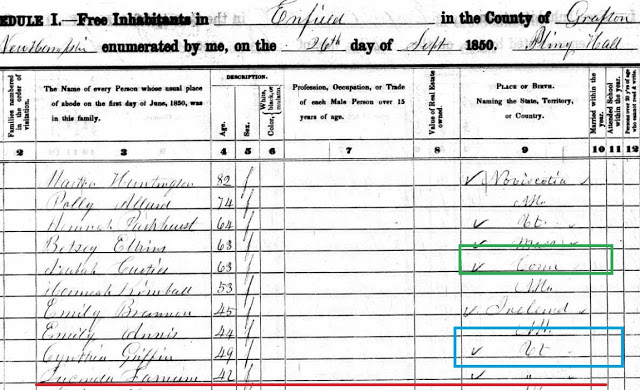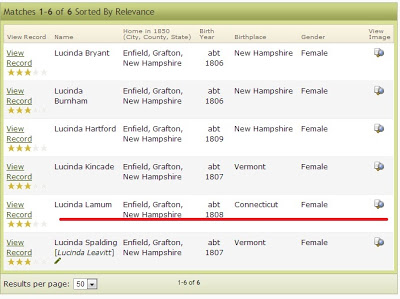
It took me a while to find Lucinda “Fairman” in the 1850 census.
I “knew” she should be in Enfield, Grafton County, New Hampshire. The difficulty was finding her. When I looked at the entry underlined in red on the image above, I knew I had the right person. Comparing the birth place that is clearly Connecticut (in green above) with Lucinda’s (in blue above) also confirmed that her place of birth was Vermont and not Connecticut.
When I went back and looked at how her entry was transcribed at Ancestry.com., I realized why I had difficulty finding here.
This shows the results screen when I searched the 1850 census for people born in 1807 (plus or minus 5 years) with first name of Luc*, living in Grafton County, New Hampshire, and a keyword of “enfield.”

Lucinda was transcribed as Lucinda Lamum, born about 1808 in Connecticut. I could see how her name was transcribed the way it was–although I disagreed with it. The error in the place of birth was not as easy to see, especially as Connecticut was clearly indicated as “Conn.” in at least one other entry on the page.
Before we complain too much, it does us well to remember that the alternative to using the indexes is to search page by page. I think I’ll stick with the indexes and keep making that list of tricks and workarounds when the humans who have made the index have transcribed something in a way in which I would not. Sometimes those differences are simply due to interpretation variations and sometimes, yes, they are due to error.

3 Responses
I have always had trouble with an 1870 census page for my father’s family (Wabash County Indiana).
In the first place, the enumerator did initials, not first names; i.e, J. Stricker, E. Strickler, and so on. Next, for some entirely unknown reason, he wrote Strickler as Suckler. We will get to the third problem in a moment.
I found them one day when I was staring dispondantly at that page and the pattern of the initials sprang to my attention. A bit of cross checken, and sure enough this was my great grandfather.
Ancestry lets you list aternates so it now reads Strickler as well as Suckler.
Third problem. In the Transcription: The Transcriber listed this entire page as Mulatto, having misread W for M. Ancestry has allowed a notation of an incorrect enumeration but will not allow any correction of this error of transcription. It has NEVER responded to queries about this. I am extremely frustrated.
I ignored this page for quite awhile because I had known that there were no blacks in that area at that time. In fact, a note on that page says that ony 1 black has been found during his eumeration in all of his part of Wabash county. So why won’t Ancestry fix this. I’m not prejudiced, by dna shows no blacks; why would I look at 30 mulatto names?
Conversely, if I were black why should I waste my time trying to establish a relationship with a group of 30 whites.
(I will add that this frustration and resolution happend early in my studies. But i’m still frustrated by Ancestry’s ademant stand against changing an enumerator mistake, the most vulnerable part of the census process.)
Ancestry also won’t fix an indexing error. The entire St Lawrence County 1850 census is crisscrossed. For example, I find William Hutton and family in Morristown and look at the record. He and wife, two children and another lady who may be an in-law. All Good, but when I click on the image, I get St Lawrence County, town of Pitcairn and totally different families. I have reported the mistakes but Ancestry does not seem interested in fixing this.
I had a similar situation in one of the censuses. Everyone in the family was listed as Indian because the enumerator intended for the I to stand for Irish.